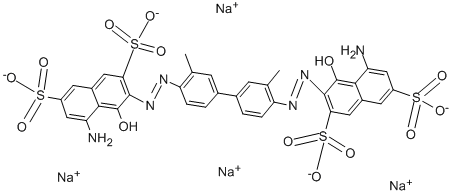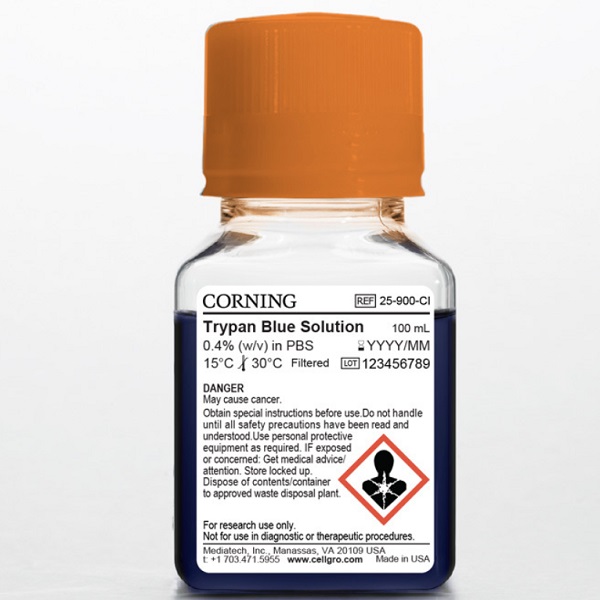
Trypan Blue
- русский язык имя
- английское имяTrypan Blue
- CAS №72-57-1
- CBNumberCB8315001
- ФормулаC34H24N6Na4O14S4
- мольный вес960.81
- EINECS200-786-7
- номер MDLMFCD00003969
- файл Mol72-57-1.mol
| Температура плавления | >300 °C (lit.) |
| Плотность накопления | 800kg/m3 |
| плотность | 1.007 g/mL at 20 °C |
| температура хранения | dry at room temperature |
| растворимость | H2O: soluble10mg/mL |
| Цветовой индекс | 23850 |
| форма | Powder |
| цвет | Dark greenish-brown |
| РН | 9.8 (10g/l, H2O, 20℃) |
| Растворимость в воде | 10 g/L (25 ºC) |
| λмакс | 607 nm |
| ε(коэффициент экстинкции) | ≥60000 at 603-607nm in methanol at 0.01g/L 60000 at 603-607nm in methanol |
| Мерк | 14,9792 |
| БРН | 4360496 |
| Стабильность | Stable. Incompatible with strong oxidizing agents. |
| Справочник по базе данных CAS | 72-57-1(CAS DataBase Reference) |
| FDA UNII | I2ZWO3LS3M |
| МАИР | 2B (Vol. 8, Sup 7) 1987 |
| Предложение 65 Список | Trypan Blue (Commercial Grade) |
| Система регистрации веществ EPA | Trypan blue (72-57-1) |
| UNSPSC Code | 41116130 |
| NACRES | NA.75 |
| Коды опасности | T,Xi | |||||||||
| Заявления о рисках | 45-41-37/38-36/37/38-22 | |||||||||
| Заявления о безопасности | 53-45-36/37/39-36-26 | |||||||||
| РИДАДР | 2811 | |||||||||
| WGK Германия | 3 | |||||||||
| RTECS | QJ6475000 | |||||||||
| TSCA | Yes | |||||||||
| кода HS | 32041400 | |||||||||
| Банк данных об опасных веществах | 72-57-1(Hazardous Substances Data) | |||||||||
| Токсичность | LD100 i.v. in rats: 300 mg/kg (Anderson) | |||||||||
| NFPA 704: |
|
рисовальное письмо(GHS)
-
рисовальное письмо(GHS)

-
сигнальный язык
опасность
-
вредная бумага
H350:Может вызывать раковые заболевания.
-
оператор предупредительных мер
P201:Беречь от тепла, горячих поверхностей, искр, открытого огня и других источников воспламенения. Не курить.
P202:Перед использованием ознакомиться с инструкциями по технике безопасности.
P280:Использовать перчатки/ средства защиты глаз/ лица.
P308+P313:ПРИ подозрении на возможность воздействия обратиться за медицинской помощью.
P405:Хранить в недоступном для посторонних месте.
P501:Удалить содержимое/ контейнер на утвержденных станциях утилизации отходов.
Trypan Blue химические свойства, назначение, производство
Химические свойства
Trypan Blue is a dark Blue crystalline solid or powder that dissolves in water to form a blue solution. It's slightly soluble in soluble fiber yarn and doesn't dissolve in other organic solvents. When mixed with concentrated sulfuric acid, it turns dark greenish-blue, and when diluted, it becomes reddish-blue. With concentrated nitric acid, it creates a brownish-gray solution. In a 10% sulfuric acid solution, its aqueous solution turns red, while with sodium hydroxide, it becomes reddish-purple.
Определение
ChEBI: Trypan blue is an organosulfonate salt that is the tetrasodium salt of 3,3'-[(3,3'-dimethylbiphenyl-4,4'-diyl)didiazene-2,1-diyl]bis(5-amino-4-hydroxynaphthalene-2,7-disulfonic acid). It has a role as a histological dye, a fluorochrome and a carcinogenic agent. It is an organosulfonate salt and an organic sodium salt. It contains a trypan blue(4-).Подготовка
3,3′-Dimethylbenzidine double nitriding, in alkaline conditions and 4-Amino-5-hydroxynaphthalene-2,7-disulfonic acid(2 Moore) coupled.Общее описание
Bluish-gray to dark blue powder.Реакции воздуха и воды
Azo dyes can be explosive when suspended in air at specific concentrations. Slightly soluble in water.Профиль реактивности
Direct Blue 14 is an azo compound. Azo, diazo, azido compounds can detonate. This applies in particular to organic azides that have been sensitized by the addition of metal salts or strong acids. Toxic gases are formed by mixing materials of this class with acids, aldehydes, amides, carbamates, cyanides, inorganic fluorides, halogenated organics, isocyanates, ketones, metals, nitrides, peroxides, phenols, epoxides, acyl halides, and strong oxidizing or reducing agents. Flammable gases are formed by mixing materials in this group with alkali metals. Explosive combination can occur with strong oxidizing agents, metal salts, peroxides, and sulfides. Direct Blue 14 is incompatible with strong oxidizing agents and strong acids.Угроза здоровью
ACUTE/CHRONIC HAZARDS: Direct Blue 14 may cause irritation and may be absorbed through the skin. It is a positive animal carcinogen. When heated to decomposition Direct Blue 14 emits very toxic fumes of nitrogen oxides, sulfur oxides, carbon monoxide and carbon dioxide.Пожароопасность
Flash point data for Direct Blue 14 are not available; however, Direct Blue 14 is probably combustible.Профиль безопасности
Suspected carcinogen with experimental carcinogenic, neoplastigenic, and tumorigenic data. Poison by intraperitoneal, intravenous, and subcutaneous routes. Experimental teratogenic and reproductive effects. Mutation data reported. When heated to decomposition it emits very toxic fumes of NOx NazO, and SOxВозможный контакт
Used in dyeing textiles; leather and paper; as a biological stain.Перевозки
UN2811 Toxic solids, organic, n.o.s., Hazard Class: 6.1; Labels: 6.1-Poisonous materials, Technical Name Required. UN3143 dyes, solid, toxic, n.o.s. or dye intermediates, solid, toxic, n.o.s., Hazard Class: 6.1; Labels: 6.1-Poisonous materials, Technical Name Required.Несовместимости
Dust may form explosive mixture with air. Trypan Blue is incompatible with strong oxidizing agents. Incompatible with oxidizers (chlorates, nitrates, peroxides, permanganates, perchlorates, chlorine, bromine, fluorine, etc.); contact may cause fires or explosions. Keep away from alkaline materials, strong bases, strong acids, oxoacids, epoxides. Azo compounds can detonate. This applies in particular to organic azides that have been sensitized by the addition of metal salts or strong acids. Toxic gases are formed by mixing materials of this class with acids, aldehydes, amides, carbamates, cyanides, inorganic fluorides, halogenated organics, isocyanates, ketones, metals, nitrides, peroxides, phenols, epoxides, acylhalides, and strong oxidizing or reducing agents. Flammable gases are formed by mixing materials in this group with alkali metals. Explosive combinations can occur with strong oxidizing agents, metal salts, peroxides, and sulfides. Trypan Blue is sensitive to prolonged exposure to heat.Утилизация отходов
Consult with environmental regulatory agencies for guidance on acceptable disposal practices. Generators of waste containing this contaminant (≥100 kg/mo) must conform with EPA regulations governing storage, transportation, treatment, and waste disposal.Trypan Blue запасные части и сырье
Trypan Blue поставщик
| поставщик | телефон | страна | номенклатура продукции | благоприятные условия |
|---|---|---|---|---|
| +8615531157085 | China | 8804 | 58 | |
| +86-0371-55170693 +86-19937530512 |
China | 21632 | 55 | |
| +86-0371-86658258 +8613203830695 |
China | 29871 | 58 | |
| +86 18953170293 | China | 2930 | 58 | |
| 18871490254 | CHINA | 28172 | 58 | |
| +86-023-6139-8061 +86-86-13650506873 |
China | 39894 | 58 | |
| +8618523575427 | China | 49732 | 58 | |
| +1-781-999-5354 +1-00000000000 |
United States | 32161 | 58 | |
| +86-0551-65418671 +8618949823763 |
China | 34563 | 58 | |
| +8615255079626 | China | 23541 | 58 |